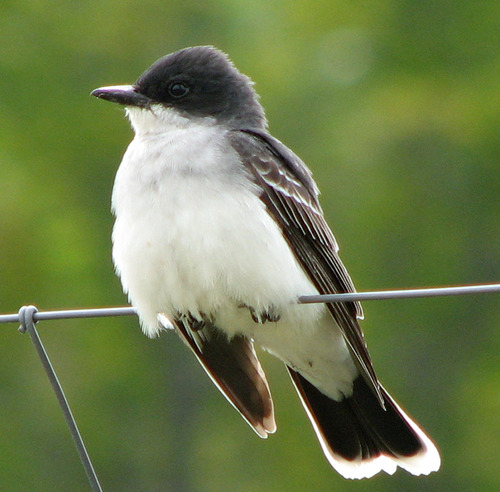
Eastern Kingbird
The Eastern Kingbird (Tyrannus tyrannus) is a charismatic flycatcher known for its bold personality and distinctive black-and-white plumage. This medium-sized bird plays a crucial role in controlling insect populations across its range, which spans much of North America. It is a highly migratory species, spending winters in South America. While not currently considered globally threatened, the Eastern Kingbird faces localized population declines due to habitat loss and pesticide use. It is a common symbol of open fields and farmlands during the breeding season.
19-23 cm
Length
33-38 cm
Wingspan
Least Concern
Conservation Status
Distribution
Breeds across North America, from southern Canada to the southern United States, excluding the arid Southwest. Migrates through Central America and winters primarily in western South America, particularly in the Amazon basin.
Lifespan
Typically 4-5 years in the wild, but can reach up to 10 years.
Eastern Kingbird's Habitat
Habitat Types
Open woodlands, Forest edges, Fields, Pastures, Wetlands, Savannas
Climate Zones
Temperate, Subtropical
Adaptations
Prefers habitats with scattered trees or tall perches for hunting and nesting. Their aggressive nature allows them to thrive in diverse, often human-altered, landscapes.
Variations
No recognized subspecies, although slight variations in size and plumage may occur across its vast range. Not Evaluated.
Appearance
Breeding Plumage
Plumage remains consistent year-round.
Seasonal Feather Changes
None
Sex Based Plumage Differences
Males and females have nearly identical plumage.
Notable Features
Dark gray upperparts, White underparts, Black head with a small, often concealed, red crown patch, White-tipped tail feathers forming a distinctive band
Diet and Feeding
Primary Foods
Flying insects, Bees, Wasps, Flies, Beetles, Grasshoppers, Moths, Sometimes fruits and berries, especially during migration and winter
Foraging Behavior
Typically perches on exposed branches, fences, or wires, sallying out to catch insects in mid-air. Also hovers occasionally to glean insects from foliage.
Specializations
Excellent aerial maneuverability for catching insects on the wing. Their broad, flat bill is well-suited for capturing flying prey.
Seasonal Diet Variations
Diet shifts to include more fruits and berries during migration and in wintering areas when insects are less abundant.
Behavior
Social Structure
Generally solitary or in pairs during the breeding season. Forms small flocks during migration and on wintering grounds.
Communication
Sharp, buzzy calls ('dzee-dzee-dzee'), Rapid twittering during aggressive encounters, Males have a complex dawn song used for territorial defense
Migration
Long-distance migrant. Travels in loose flocks, often following coastlines or river valleys. Navigates using a combination of visual landmarks, the Earth's magnetic field, and possibly celestial cues.
Territorial or Group Behaviors
Highly territorial during the breeding season, aggressively defending nesting and feeding areas from other birds, including much larger species like hawks and crows. Hence the name 'Kingbird'.
Conservation
Threats
Habitat loss due to agriculture and urbanization, Pesticide use, which reduces insect prey and can directly poison birds, Collisions with vehicles and buildings
Protection Programs
General protections under the Migratory Bird Treaty Act in the US and Canada, Habitat conservation efforts by various conservation organizations
Local National Laws
Protected under the Migratory Bird Treaty Act in the United States and Canada.
Population Trend
Generally stable, but some regional declines have been observed.
Population Estimates
Global population estimated at 52,000,000 individuals (Partners in Flight).
Interesting Facts
They are known for their fearless attacks on much larger birds.
Eastern Kingbirds will relentlessly mob hawks, crows, and even eagles that venture too close to their nests.
The genus name 'Tyrannus' means 'tyrant', 'despot', or 'king'.
This refers to their aggressive defense of territory.
They can catch and eat honeybees without being stung.
They are thought to have some level of immunity or behavioral technique to avoid stings, although the exact mechanism is not fully understood.
Faqs about Eastern Kingbird
What should I do if I find a baby Eastern Kingbird?
If the bird appears injured or truly orphaned, contact a local wildlife rehabilitator. It's best to leave fledglings alone unless they are in immediate danger, as the parents are likely nearby.
How can I attract Eastern Kingbirds to my yard?
Provide open areas with perches, plant native trees and shrubs, and avoid using pesticides. A water source can also be attractive.
Are Eastern Kingbirds harmful to honeybee populations?
While they do eat honeybees, they are not considered a major threat to beekeeping operations. Their diet is diverse, and they consume many other insects.
Do Eastern Kingbirds return to the same nesting site each year?
Eastern Kingbirds often exhibit site fidelity, meaning they may return to the same general area or even the same nest to breed year after year. However, this is not always the case, and factors like habitat changes or nest success in previous years can influence their choice.
Copyright @ Nature Style Limited. All Rights Reserved.
 English
English